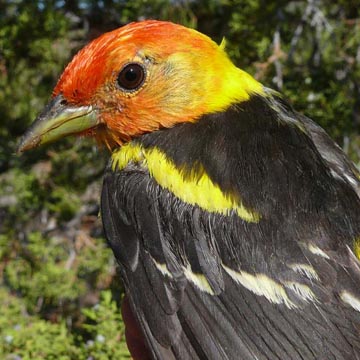An Introduction to Bird Songs
Admission
- Free
Location
3540 Orange St.
Los Alamos, NM 87544
United States of America
Description
 Have you ever been confused by a finch warbling or a warbler trilling? This class is your chance to start learning or improve your skills at identifying common birds of the Jemez Mountains by sound. The class will start with an introduction to song types. We will focus next on those birds that trill. Much of the class will focus on distinguishing birds that seem to have robin-like songs, such as Black-headed Grosbeak and Western Tanager. After these robin-like songsters, we will focus time on some non-musical complex songs such as those from flycatchers and sparrows. We will end the class with birds like our Ruby-crowned Kinglet and Greet-tailed Towhee that have complex musical songs.
Have you ever been confused by a finch warbling or a warbler trilling? This class is your chance to start learning or improve your skills at identifying common birds of the Jemez Mountains by sound. The class will start with an introduction to song types. We will focus next on those birds that trill. Much of the class will focus on distinguishing birds that seem to have robin-like songs, such as Black-headed Grosbeak and Western Tanager. After these robin-like songsters, we will focus time on some non-musical complex songs such as those from flycatchers and sparrows. We will end the class with birds like our Ruby-crowned Kinglet and Greet-tailed Towhee that have complex musical songs.
Handouts with sonograms and descriptions of specific bird songs will be provided. Bring your field guide to consult while we listen to high-quality locally produced recordings. All participants will get a CD of local bird sounds and a booklet with sonograms to take home with them. Bring your lunch and we will take a bird walk into the canyon below PEEC during the lunch break.
This class will be offered free to those who agree to count birds at Bandelier National Monument for a minimum of four hours on Saturday, May 10, 2014 as part of the International Migratory Bird Day (IMBD). Space is limited to only 12 participants, so be sure to register with PEEC soon. If space remains on May 1, we will open up registration to those who cannot spend four hours participating in the bird count. The cost to attend the program without volunteering will be $120.
For more information about the program, you can contact Stephen Fettig at 505-672-3861 x 706.
The International Migratory Bird Day (IMBD) officially takes place on the second Saturday in May in the U.S. and Canada. To the south, migratory birds have left, heading for breeding sites to the north. Spring migration bird counts conducted across the continent on IMBD provide a snapshot of bird migration in progress. Winter habitats are just as important as nesting sites, and their quality influences nesting success. Stopover sites, the places where birds rest and refuel during migration, are also critical. Spring migration bird counts such as the one on May 10, 2014 help document the importance of stopover sites, as well as documenting difference between years in the pattern of migration.
To see in real time where people are submitting their bird observations, from all over the world, visit http://ebird.org/ebird/livesubs
